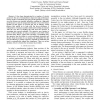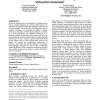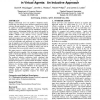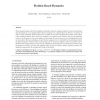202 search results - page 27 / 41 » Modeling collision avoidance behavior for virtual humans |
ICRA
2005
IEEE
14 years 1 months ago
2005
IEEE
— It has been demonstrated in a number of robotic areas how the use of virtual fixtures improves task performance both in terms of execution time and overall precision, [1]. How...
ATAL
2005
Springer
14 years 1 months ago
2005
Springer
In the past emotions have been dismissed as a distraction to the logical, scientific thought process. More recently however, the importance of emotion in human-like intelligence a...
ATAL
2009
Springer
14 years 2 months ago
2009
Springer
Human interaction depends on several individual factors such as personality, social relations, age or gender. But also the society we live in influences our behaviour. Thus cultur...
ATAL
2008
Springer
13 years 9 months ago
2008
Springer
Humans continuously assess one another's situational context, modify their own affective state, and then respond based on these outcomes through empathetic expression. Virtua...
JVCIR
2007
13 years 7 months ago
2007
The most popular approaches for the simulation of dynamic systems in computer graphics are force based. Internal and external forces are accumulated from which accelerations are c...




